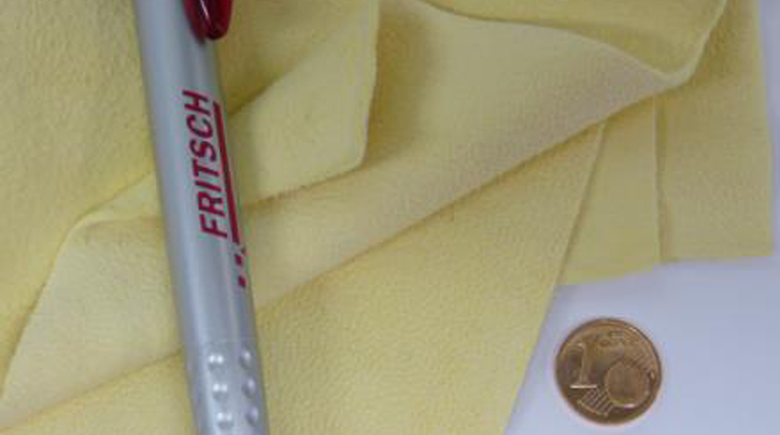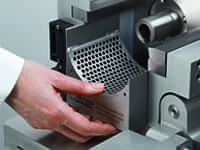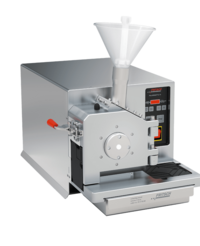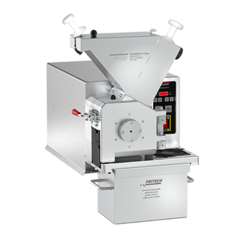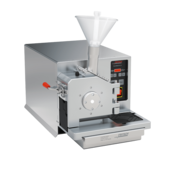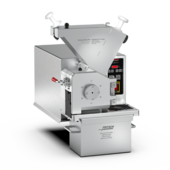Back to overview
Preparing leather for chemical tests
Leather for various applications
Leather is produced by tanning of skin. Modern technologies of the leather production ensure that the leathers are available contaminant free.
Leather as a material with emotions has a wide area of application. This is due to the versatility of the leather types as well as the possibility to adjust the characteristics according to the desired requirements.
Leather found a large market in the production of furniture and upholstery. Additionally leather is also used in the garment industry for example for the production of jackets, pants, gloves and of course also for protective clothing and active wear like for example motor cycle jackets. To be mentioned of course are the versatile types of leathers in the shoe sector.
Trust is good, testing is better
The diverse leather products must be safe for the consumer. This requires continuous tests of the leathers in regards to contaminants starting with the skin to the wet-white and wet-blue up to the finished product.
For this the appropriate comminution of the sample material is required. According to DIN EN ISO 4044
“Leather- Chemical Tests – Preparation of samples for chemical tests”, leather is prior to the test in regards to chemical parameters to be comminuted smaller than 4 mm. This comminution is preferably carried out with a knife mill. The comminution with a mill enables an efficient and reproducible sample comminution. The milling process may not alter the contaminant content to be determined.
The leather amounts available for testing are often short on supply. Consequently the comminution shall be if possible low-loss. This means that the rest of the material remaining in the grinding chamber shall be as small as possible and the warming of the sample if possible avoided. With a common knife mill this is hard to achieve. Consequently was the focus of the search to find a mill with a small grinding chamber and a slow application of cutting energy.
The search for a suitable mill
Often the leather samples to be tested for contaminants are manually cut with a pair of scissors. Besides the extreme workload, especially during the sample preparation of hard leathers is the manual comminution not really reproducible. In order to minimize the effects of the sample preparation on the analysis result, a knife mill was sought after according to the following selection criteria:
- Comminution of leather of the most diverse consistency down below 4 mm - Avoidance of thermal damage of the material - Simple cleaning of the mill to avoid cross contamination
A pre-selection of all on the market available cutting mills was conducted. Short listed due to the extreme fast and simple cleaning properties were the Universal Cutting Mills PULVERISETTE 19 from the FRITSCH GmbH [1].
Advantages of FRITSCH Cutting Mills
With all models of the FRITSCH Universal Cutting Mills the entire grinding chamber can be opened in a few seconds and the rotor as well as the sieve cassette can be removed with one motion without tools.
The housing and lid can be opened completely; the closing lid is simply lifted off the hinge: Resulting in a completely opened empty grinding chamber with minimized dead space for simple fast cleaning and reliable protection against cross contamination.
The Universal Cutting Mill PULVERISETTE 19 works with variable rotational speed between 300-3000 rpm
The high rotational speed causes a lower feed size of the sample so the mill doesn’t get obstructed. On the other hand a smaller final fineness and a high throughput through the sieve are obtained. Consequently the residue in the grinding chamber is low. But with increasing rotational speed the temperature load on the sample increases also. A temperature increase was clearly noticeable during sample comminution with the PULVERISETTE 19. This effect was comparable with the warming of the sample when utilizing comparable mills of other manufacturers. For this reason the PULVERISETTE 19 large was included in further tests.
The Universal Cutting Mill PULVERISETTE 19 large works with variable rotational speed between 50-700 rpm
The PULVERISETTE 19 large enables due to its larger grinding chamber a simpler and faster sample feed of even stiff leather samples. Sample pieces of 120 x 85 mm in comparison to 70 x 80 mm (PULVERISETTE 19) may be added. The cutting forces of the PULVERISETTE 19 large due to the low rotational speed of 50-700 rpm are applied very slowly. The thermal load of the sample is therefore very low. Also, the low rotational speed of the cutting rotor produces barely an air current which could expel highly volatile substances during the comminution process. However, it is to be expected that the material throughput through the sieve is worse and material will remain in the grinding chamber. This was already taken into account though during the tests; and the share processed through the sieve was examined compared to the share remaining in the grinding chamber.
Comminution of the most diverse leather samples in comparison
In order to test the appropriateness of the PULVERISETTE 19 large, leather of very different quality was selected for tests.
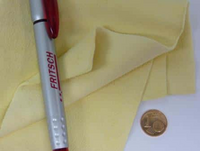
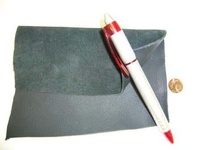
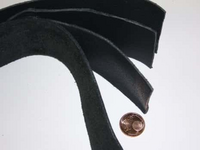
The results of the first comminution are summarized in table 1. Often the lot sizes available for the analysis are relatively small. Therefore were real, respectively common amounts comminuted and the amount put through the 4 mm sieve (output weight) and the remainder (rest) in the grinding chamber determined. Additionally, the temperature of the processed material and the in the grinding chamber remaining material was identified [2].
Table 1: Result of the sample comminution with the PULVERISETTE 19l
| Leather | Initial weight / [g] | Output weight / [g] | Remainder in the mill/ [g] |
Sample temperature / [°C] |
Temperature remainder in grinding chamber / [°C] |
| Very soft leather | 9.6 | 5.2 | 4.4 | 20.5 | 20.1 |
| Soft leather medium thickness | 28.9 | 20.0 | 7.8 | 25.6 | 24.8 |
| Thick stiff leather | 98.0 | 77.8 | 18.7 | 32.0 | 32.9 |
The in the mill remaining amount of the leather in % is directly proportional to the initial weight. The temperature of the sample rises with the stiffness of the leather. The thick leather shows temperatures barely above 30 °C. Bothersome though was the relatively high share of all types of leather in the grinding chamber.
Grinding tests with the PULVERISETTE 19 and 19l for analytical tests
For the evaluation of the influence of the type of comminution on the chemical parameters, were in an additional test comparatively, the very soft leather (sample 1) and the soft leather with medium thickness (sample 2) comminuted with the PULVERISETTE 19 and PULVERISETTE 19 large [3]. Additionally the samples were cut with scissors. The ground and cut samples were examined for the following chemical parameters:
- Formaldehyde content for the very soft leather according to DIN EN ISO 17226-1
- Dichloromethane soluble materials for the soft leather with medium thickness according to DIN EN ISO 4048
Sample 1 (very soft leather) was fed uncut into the PULVERISETTE 19 large 50-700 rpm and comminuted. The sample was divided with a 4 mm sieve. Up to approximately 50 % of the sample remained in the grinding chamber. The sample temperature rose from 21.0 °C to 22.3 °C. The sample was 1/1 in the sample container below the sieve (output weight) and the sample 1/2 in the grinding chamber (remainder in the mill).
The sample 1/3 was at first pre-cut and then comminuted with the PULVERISETTE 19 with a 4 mm sieve. The sample temperature rose from 21.0 °C to 30.8 °C. The comminution with the PULVERISETTE 19 lead to a higher thermal load of the examined sample in comparison to the comminution with the PULVERISETTE 19 large 50-700 50-700 rpm. In table 2, the results of the chemical tests are summarized.
Table 2: Test results of sample 1 (very soft leather)
| Parameter | Sample 1 | Sample 1/1 sieving area |
Sample 1/2 grinding chamber |
Sample 1/3 |
| Comminution | scissors | PULVERISETTE 19 large | PULVERISETTE 19 large |
PULVERISETTE 19 |
| Formaldehyde content in mg/kg referring to dry substance DIN EN ISO 17226-1 HPLC-determination |
612 |
545 |
588 |
572 |
The experimental data shows that the determined formaldehyde content of the sample comminuted with the PULVERISETTE 19 and also the PULVERISETTE 19 large is lower in comparison to the determined formaldehyde content of the cut sample.
Sample 2 (soft leather medium thickness) was fed uncut into the PULVERISETTE 19 large and comminuted. The sample was divided with a 4 mm sieve. Approximately 27 % of the sample remained in the grinding chamber and the sample temperature rose from 21.0 °C to 26.4 °C. The sample 2/1 (output weight) passed the 4 mm sieve and was inside the collection vessel and the sample 2/2 in the grinding chamber (rest in the mill). The sample 2/3 was again pre-cut and comminuted with a 4 mm sieve. The sample temperature rose from 21.0 °C to 39.0 ° C. In table 3 the results of the chemical tests of sample 2 are summarized.
Table 3: Test results of sample 2 (soft leather of medium thickness)
| Parameter | Sample 2 |
sample 2/1 sieving area |
Sample 2/2 grinding chamber |
Sample 2/3 |
| Comminution | scissors | PULVERISETTE 25 | PULVERISETTE 25 | PULVERISETTE 19 |
| Dichloromethane extract (fat content) in % |
11.0 |
11.5 |
10.6 |
11.7 |
The comminution with the PULVERISETTE 19 leads to a higher thermal load of the examined sample. The dichloromethane soluble share was determined in the same size range independent of the comminution.
The considerably larger grinding chamber of PULVERISETTE 19 large in comparison to the PULVERISETTE 19 is an argument against utilizing this Cutting Mill. This becomes a problem if only small sample amounts are available and too great of a percentage remains in the grinding chamber. Consequently small sample amounts can only be ground with restrictions or they have to be cut with scissors. When utilizing the PULVERISETTE 19 large, the fractions from the grinding and sieving chamber would have to be combined. Therefore is the utilization of this mill not recommended for small sample amounts.
A new mill was designed
The advantage of a small grinding chamber, which avoids the loss of material, was combined with the advantage of low number of revolutions, which avoids too low values of easily volatile substances. This means for the practical implementation: the gear motor of the Power Cutting Mill was combined with the smaller cutting chamber of the Universal Cutting Mill and offers therefore the following advantages:
- Sample preparation of leather samples in a mill which is absolutely easy to clean
- Thermal damage of the sample is avoided
- The loss of easily volatile substances is minimized in the air current
- The pre-comminutuion of stiffer samples is for the most part obsolete
- Even stiffer leather can be comminuted without blocking of the mill
Verification of the milling results with the modified Cutting Mill in comparison to the samples cut with scissors
Initially, the mill was tested in regards to handling during routine operations. It became evident, that it is mandatory to be able to remove the cutting rotor when changing samples. Therefore a cleaning with a vacuum cleaner is sufficient. Noise pollution is not above the usual measure for a laboratory. Approximately 1 – 3 % of the used material remained in the grinding chamber.
Several samples were again examined in consideration of in table 4 defined parameters. For this a part of the sample was manually cut with scissors and another part comminuted with the mill. The results showed a good compliance of the results which were obtained with the different comminution technologies.
Table 4: Experiments for verification of the mills
| Parameter | Test process | Unit | Materials | values cut |
values comminuted |
| Migration of certain elements Barium Chromium |
DIN EN 71-3 | mg/kg | leather light orange |
1.5 0.8 |
2.3 1.8 |
| PCP | DIN EN ISO 17070 | mg/kg | leather grey leather light brown leather taupe |
0.8 1.6 0.1 |
1.1 2.0 0.2 |
| Dichloromethane-Extract | DIN EN ISO 4048 | %1 | leather black | 8.5 | 7.9 |
| Chromium oxide as Cr2 O3 | DIN EN ISO 4989 | %1 | leather black | 4.1 | 3.8 |
| Formaldehyde content | DIN EN ISO 17226-2 | mg/kg1 | leather light brown | 26.2 | 29.9 |
| Formaldehyde content | DIN EN ISO 17226-2 | mg/kg1 | leather grey | 2.4 | 1.9 |
| Formaldehyde content | DIN EN ISO 17226-1 | mg/kg1 | leather grey | 1.7 | 1.6 |
| Formaldehyde content | DIN EN ISO 17226-2 | mg/kg1 | leather brown | 3.0 | 3.5 |
| Formaldehyde content | DIN EN ISO 17226-1 | mg/kg1 | leather brown | 3.6 | 3.9 |
| pH-value | DIN EN ISO 4045 | leather | 4.70 | 4.65 |
1 in regards to dry substance
The determined values for the formaldehyde contents, the chromium oxide content, the dichloromethane soluble share and the PCP are in the zone of fluctuations of the method.
Distinct multiple findings are found for the metals barium and chromium after the extraction with 0.07 mol/I HCI. For this reason the influence of the rotor material was examined in regards to the metal values.
Examination of the influence of the material of the rotor on the extractable metal content
Chromium-free leather was comminuted parallel with a rotor made of tool steel, made of hardmetal tungsten carbide and chromium-free steel. The leather was then according to DIN EN ISO 71-3 hydrochloric extracted. In table 5 the results are summarized.
Table 5: Influence of the material of the rotor on the determination of the metals from the hydrochloric extraction
| Rotor | Barium / [mg/kg] single value |
Barium / [mg/kg] mean value |
Chrome / [mg/kg] single value |
Chrome / [mg/kg] mean value |
| Tool steel | 11.0/7.5 | 9.2 | 11.0/12.0 | 11.5 |
| Hardmetal tungsten carbide | 6.5/4.5 | 5.5 | 10.5/9.9 | 10.2 |
| Chromium-free steel | 4.8/11.0 | 7.9 | 12.0/9 | 10.5 |
Leather comminuted with rotors of different quality show the obtained values for the examined metals are comparable among one another.
The deviations of the analyses results are - despite the best sample preparation – caused by always occurring mistakes of sampling and the matrix. Consequently the deviations are to be tolerated. The in table 4 shown multiple findings are based in the better degree of breakdown via milling in comparison to cutting with scissors.
Summary
The new designed mill consisting of the cutting tools of the PULVERISETTE 19 and the gear motor of the PULVERISETTE 19 large enable the comminution of leather without noticeable thermal load and without blockage of the mill even with very stiff leather. With the rotors made of tool steel, chromium-free steel and hardmetal tungsten carbide is a comminution without noticeable cross contamination of the sample from cutting tools possible. Therefore the selection criteria demanded in the beginning are met.
-
Download the FRITSCH-report as PDF file
-
Detailed grinding reports
-
Sources and continuative literature
[1] d_Schneidmühlen_fritsch.pdf
[2] Fritsch GmbH, Mahlprotokoll 2010
[3] FILK gGmbH Abschlussbericht zur Einführung der Schneidmühle in den Routinebetrieb, 2011Co-authors of report: U. Morgenstern, H. Schulz, FILK - FILK Research Institute of Leather and Plastic sheeting gGmbH
Norm DIN EN ISO 4044: 2017
Back to overview

